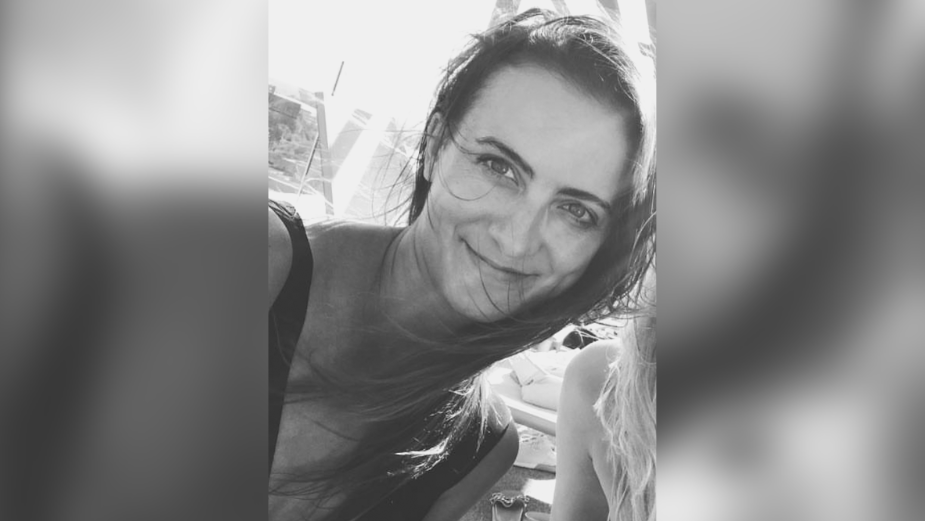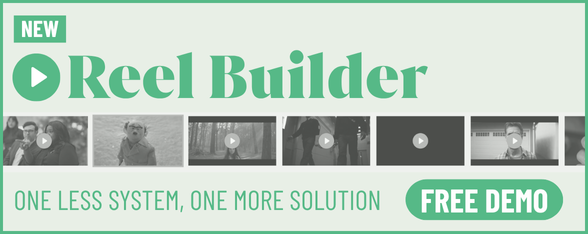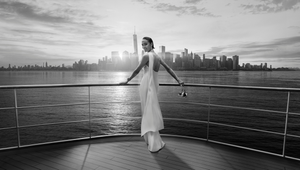
Step into Natalie Rae’s Unconventional World of Wonder

Studio RM, the creative studio specialising in colour grading and post production across film, print, and digital, is partnering with Little Black Book to sponsor The Directors channel. A space for celebrating directors who create aesthetically beautiful and nuanced imagery, the creative potential of technology, and diving into the trends in contemporary culture which these visionary minds so often spark. In this series, we’ll be highlighting directors who have a distinctive creative voice, and who are championing new and exciting visual styles through fashion, music, and culture.
Natalie Rae has an effervescence about her that emanates from every project she turns her hand to. Taking inspiration from a never-ending conveyor belt of life experiences - 90s hip hop and pop, conversations with strangers, the natural environment of beautiful British Columbia - the award-winning director pays close attention to the raw energy that surrounds her. The idea that ‘creativity is a way of life’ is ingrained in the filmmaker.
Growing up in Vancouver, Natalie’s parents were a major source of inspiration as advocates of adventure, spontaneity and self expression. Being around her mother’s yoga studio and pursuing her love of dance early on in life, led Natalie to discover the body as a medium of expression. This affinity for dance, movement and music is woven into the fabric of Natalie’s creative language.
A recent career high came in the shape of lululemon's ‘Feel Canada’ Olympic collection campaign which presented an opportunity to “paint Canada in a fresh new light”. Co-produced by Object&Animal and OPC, the three minute spot is at once both a heartfelt love letter to Canada and a timeless, masterful commercial that is sure to inspire audiences for years to come.
Ahead of the release of her upcoming debut feature film, DAUGHTERS, the director sits down with LBB’s April Summers to open up about her creative journey so far.
Name: Natalie Rae
Location: Los Angeles
Repped by: Object&Animal, OPC
LBB> What influenced you the most growing up and how did these influences help shape your creative voice?
Natalie> I’m a pretty nostalgic person, so a lot of my early years are still finding their way into my creative voice, and music has been a huge influence for me. Salt-N-Pepa were one of my first loves; I remember memorising the lyrics from the back of one of their tapes. Then, when Alanis Morissette put out Jagged Little Pill, I was awestruck. Singing with her made me feel something that I never had before. For both, I was enthralled by their raw energy. Unfiltered, unapologetic, sexy, innovative women. The first R rated movie my parents let me watch was ‘The Commitments’ - I remember being so drawn to soul music and the spirit that came along with it.
Long summer drives through the Okanagan Valley in BC with my family, blasting Van Morrison as we drove through the countryside, will always be one of my best memories. My parents injected travel, adventure and spontaneity into my sense of comfort and creativity. Conversations with strangers, staying late at dinner parties, sneaking into hotel pools, falling asleep in the booths of restaurants – all these experiences showed me how to trust and that creativity is a way of life.
Also, my piano teacher, my alternative school, my few close friends, all had a big influence on how I would shape my creative voice and how I created my own little unconventional world.
LBB> Did growing up in Vancouver inspire you creatively?
Natalie> Growing up in Vancouver you can’t help but feel connected to nature in a way that I’ve not felt in other cities. Living within close confines to the mountains and the old growth forests, with the rain storms and the beaches – there are all these awe inspiring natural forces around you. When you’re a kid you definitely take it for granted. I had to do a lot of travelling to come back and appreciate how majestic British Columbia is. Nature teaches you how to pay attention to energy and that’s so special to learn as a kid.
LBB> The style of a film changes brief by brief, but how would you underpin your general visual style? Are there certain factors that you could pinpoint as a signature for you?
Natalie> If there’s an emotional truth I can get behind, then it’s a brief that I’ll respond to. I try to ride a line of visuals that are real yet heighten the emotion of the subjects. I love things that are visually arresting but don’t feel too crafted. I always like to embrace imperfections and in-between moments – there’s an aliveness to that which I try to protect in my visual style.
LBB> How important is the role of colour / grade in the overall look and feel of a film?
Natalie> It depends on the project. For me the colour and grade should enhance small details but never overpower a narrative. I don’t usually work on grades that drastically change a look, I prefer to shoot on film which naturally has such great colour, then the grade becomes about balancing and enhancing what’s there.
LBB> How do you use things like colour and grade to accentuate your vision?
Natalie> Good colorists are like magicians. Their vision is so refined. It’s such a great experience when you don’t want to really show a change, but you want people to feel it. Like enhancing a sparkle in someone's eyes or bringing a hue to the highlights of a window – there are just tiny details that can help the feeling of an overall image.
I try to stay quite de-saturated and keep it real, but I’ve been trying to get more comfortable with more colour the last couple years which has been fun! I enjoy using a little bit of pink and purple in my undertones. Sometimes choosing one or two primary colours that are also brought out in the production design can be a fun but still real way of making the colours pop. It brings a higher energy for sure.
LBB> Do you have a niche craft obsession? If so, was it an obsession straight away or something that has developed over the course of your career?
Natalie> I obsess over watching the rushes. I love the edit process and I need to make sure I’ve combed over all the footage to find any of those spontaneous moments that might get overlooked; any in-between moments or seconds where we weren’t ‘rolling’. Looking at footage is so subjective, and I usually don’t feel good unless I can really mine through my performances. A lot of new ideas that aren’t in the initial script come to me during this phase, so I often take shots and new ideas back to my editors.
LBB> What was the reaction to your FEEL CANADA spot for lululemon? How significant was the colour / grade for this film?
Natalie> We had such a beautiful reaction to our lululemon ad. Lots of people called me to say how emotional, surprised and inspired they had felt watching it. We’re living in such a divided time and looking at how Canada brings people together was a powerful motif. Many Canadian’s often leave their own country - including myself - so when I took a moment to look back and paint Canada in a fresh new light, to look at the diversity and beauty it has as a culture, it honestly made me so proud to call it home. Canada doesn’t have a very developed visual identity, so it was such a pleasure to push the needle on this a bit.
It was shot over a six month long production that included a week with the Saugeen Indigenous Community outside of Toronto. It was a unique mix of a real documentary approach, narrative, dance and sport styles integrated into one. The humanity, the style and the ways of blending different communities made it a special project. The choreography also functioned really well as the glue, a symbolic element that enhanced a feeling of support and connection.
The grade for this spot was super important. We filmed on different mediums and we needed the grade to help bring out the different threads. We filmed the athletes in a more classic style on Alexa, so we made the grade more bold and clean for them. Then for the Canadian memories, we filmed on 16mm film, to keep the visuals more muted and soft. For the dancers and nature, we also shot on Alexa, but wanted those to find a balance between the future and the past. Overall, the grade felt strong, rich reds and greens that still appeared quite natural, focusing on texture over colour intensity.
LBB> You often use choreography as an emotive tool in your work – what is your connection with dance and how does it influence your approach to creating a treatment for a spot?
Natalie> I grew up doing every style of dance, so when I started out in music videos that language was easier to speak than cinematography, for me. Between dance and my years learning to write music and play piano, making music videos came naturally. I’m so glad there was a way for me to begin to communicate in film. It took much longer for me to be comfortable in a narrative or commercial space. My Mom also ran a yoga studio, so I think body language, using the body to tell stories, and seeing energy in the body was something I have always loved. Just like a photo can express an idea that would take a thousand words, I feel the same about dance. It’s so honest and emotional – the translation is universal and instant.
It’s only on certain spots that bringing in choreography feels right, but when clients are open to that it’s one of my favourite parts. Working with choreographers and dancers brings such a big lifeforce to set, those shoots have been some of my favourite days. Playing music on set really meshes the crew, agency, client and performers, creating a very special dynamic.
LBB> What are you currently working on that you are excited to talk about?
Natalie> I am currently in the final months of post on my feature documentary, DAUGHTERS. After 7 years in the making, words cannot express how good it feels to say that! It’s been a very hard, very intense journey, so I am thrilled we are getting ready to share the film with the world.
It’s a coming of age story about girls with incarcerated fathers in Washington DC. It centres around a father daughter dance that a 12 year old girl came up with to take her future into her own hands and reconnect with her father in jail. I’m collaborating with Angela Patton, who runs Girls For A Change and who’s TedTalk sparked the initial idea for the film. We are thrilled to soon be sharing the film, hopefully in 2023!
LBB> Are there any insights you can draw from contemporary culture that you feel are going to shape the future of film?
Natalie> There’s always a dialogue, isn’t that what film is? I hope who a ‘director’ is starts becoming more than a sex or race box to tick. I hope we reinvent the way film sets operate, to redefine what leadership looks like and what form that takes in a director. I hope we start to find better ways of creating sustainable productions. I hope we start to create a less fear driven ecosystem for artists in our time.















